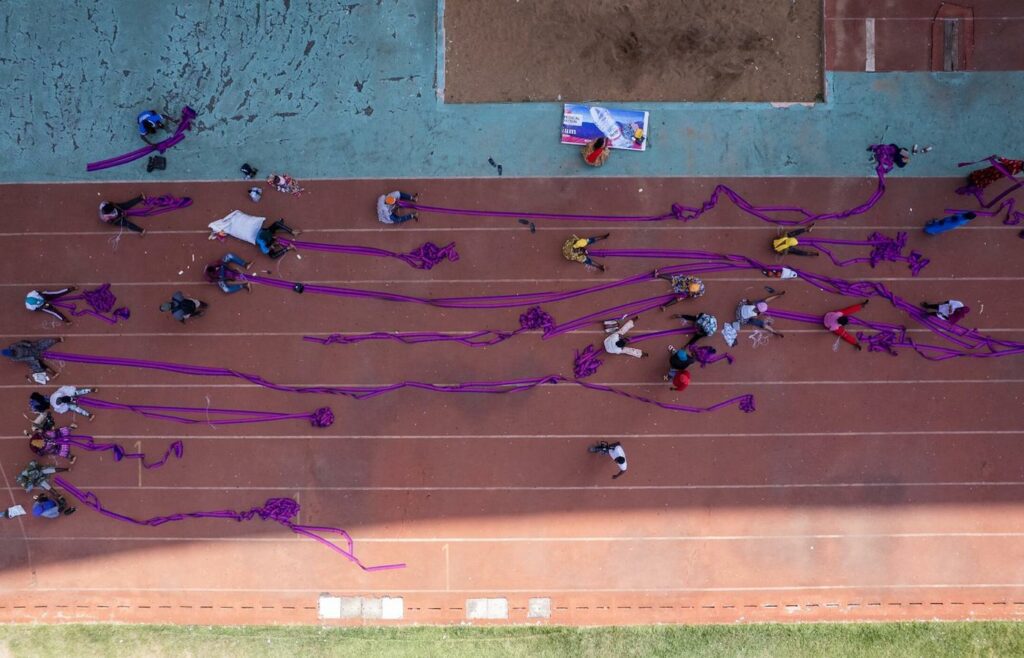The Barbican Centre, London, United Kingdom
10 Apr 2024 - 18 Aug 2024

Credit: 5. Ibrahim Mahama, Purple Hibiscus, 2023-24. Courtesy Ibrahim Mahama, Red Clay Tamale, Barbican Centre, London and White Cube.
The Barbican announces the first large-scale public commission to be presented in the UK by Ghanaian artist Ibrahim Mahama (b.1987), opening in April 2024. Transforming the Barbican’s famous Lakeside Terrace, which sits at the heart of the brutalist complex, the site-specific artwork will dramatically envelop the building’s iconic concrete exterior with approximately 2000 square metres of bespoke woven cloth.
Purple Hibiscus, named after Chimamanda Ngozi Adichie’s eponymous 2003 novel, is an ambitious new commission created in collaboration with hundreds of craftspeople from Tamale in Ghana. The work has been woven and then sewn by hand to produce colossal panels of pink and purple fabric that will be fitted to the brutalist planes of the Barbican’s Lakeside façade.
Embroidered onto the cloth are approximately 100 batakaris – robes worn by Northern Ghanaian royals and ordinary people – which Mahama has collected through a process of exchange and barter from numerous communities across Northern Ghana. These precious textiles, often saved by families over generations, tucked away in wardrobes or stored below beds, carry the imprints of the lives, lineage and power of the figures they once clothed. Worn, degraded and bearing traces of years of use, these smocks are testaments to the endurance of traditional belief systems, and the continued relevance of intergenerational knowledge. Incorporating these smocks into the commission carries forward Mahama’s deep interest in the life cycles of textiles and what can be learnt from the historical memories embedded within them.
By collaborating with networks of women weavers and sewing collectives for the production of Purple Hibiscus, Mahama is actively engaging with local economies. He believes that the making of his artworks should be connected to their local contexts and the lives of those communities. The vibrant hues of this particular work are a departure from his usual palette and are an expression of allyship with marginalised communities while aiming to build new alliances.
Transported to the Barbican’s Lakeside Terrace, Mahama’s monumental commission gains new resonance. The Barbican Centre stands on the former Cripplegate parish, which was largely destroyed during the Second World War. A centre for the rag trade in London, the area was sought out for the buying, selling and production of cloth. Viewed together, the hand stitched panels of Purple Hibiscus and the hand pitted concrete of the Barbican’s rough concrete façade offer an expanded reflection on the power and significance of collective labour.
Mahama’s practice is grounded in the democratic belief that art belongs to all. Fearless when it comes to scope and scale, his works claim space, demand questions and enquiry, but also reflect solidarity with the craftspeople, weavers and makers in Ghana with whom he collaborates. Committed to institution building, his Red Clay Studio and Savannah Centre for Contemporary Art in Tamale, Ghana, provide social infrastructure for arts education, exhibition making and residencies. At the heart of Mahama’s practice is his conviction that Ghanaians, and all those outside of the exclusive environs of the art market, should have the opportunity to engage with art.
The commission forms part of the upcoming exhibition Unravel: The Power & Politics of Textiles in Art, which will open at Barbican Art Gallery on 13 February 2024.
Mahama’s commission reflects the Barbican’s commitment to platforming the best artists from around the world, delivering a diverse international programme across the Barbican Art Gallery, The Curve and beyond. Cementing the centre’s reputation as one of the UK’s leading commissioners of new artistic work, Purple Hibiscus forms part of a new strand within the Barbican’s visual arts programme which invites contemporary artists to create work in response to its unique public spaces. This exciting programme activates the Barbican’s unparalleled setting – recognised as one of the most significant architectural achievements of the 20th century – bringing artistic interventions and introducing dynamic, invigorating and stimulating art practices to new audiences.